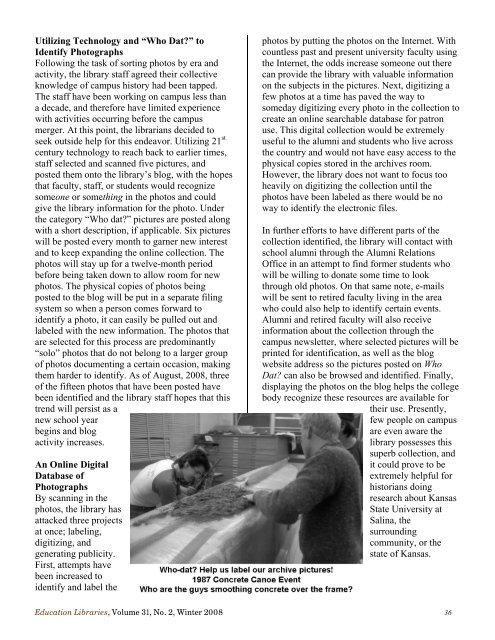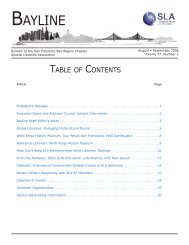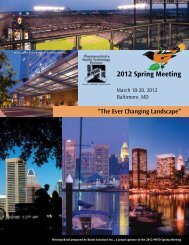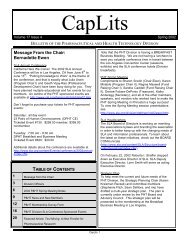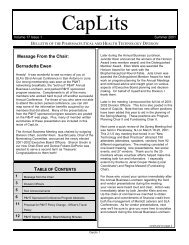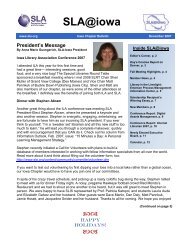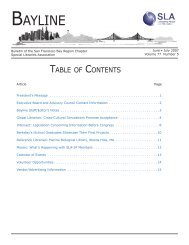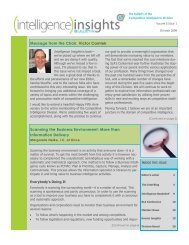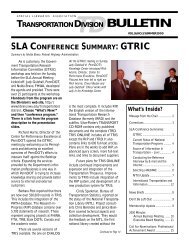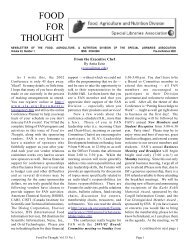Education Libraries - Special Libraries Association
Education Libraries - Special Libraries Association
Education Libraries - Special Libraries Association
You also want an ePaper? Increase the reach of your titles
YUMPU automatically turns print PDFs into web optimized ePapers that Google loves.
Utilizing Technology and “Who Dat?” to<br />
Identify Photographs<br />
Following the task of sorting photos by era and<br />
activity, the library staff agreed their collective<br />
knowledge of campus history had been tapped.<br />
The staff have been working on campus less than<br />
a decade, and therefore have limited experience<br />
with activities occurring before the campus<br />
merger. At this point, the librarians decided to<br />
seek outside help for this endeavor. Utilizing 21 st<br />
century technology to reach back to earlier times,<br />
staff selected and scanned five pictures, and<br />
posted them onto the library’s blog, with the hopes<br />
that faculty, staff, or students would recognize<br />
someone or something in the photos and could<br />
give the library information for the photo. Under<br />
the category “Who dat?” pictures are posted along<br />
with a short description, if applicable. Six pictures<br />
will be posted every month to garner new interest<br />
and to keep expanding the online collection. The<br />
photos will stay up for a twelve-month period<br />
before being taken down to allow room for new<br />
photos. The physical copies of photos being<br />
posted to the blog will be put in a separate filing<br />
system so when a person comes forward to<br />
identify a photo, it can easily be pulled out and<br />
labeled with the new information. The photos that<br />
are selected for this process are predominantly<br />
“solo” photos that do not belong to a larger group<br />
of photos documenting a certain occasion, making<br />
them harder to identify. As of August, 2008, three<br />
of the fifteen photos that have been posted have<br />
been identified and the library staff hopes that this<br />
trend will persist as a<br />
new school year<br />
begins and blog<br />
activity increases.<br />
An Online Digital<br />
Database of<br />
Photographs<br />
By scanning in the<br />
photos, the library has<br />
attacked three projects<br />
at once; labeling,<br />
digitizing, and<br />
generating publicity.<br />
First, attempts have<br />
been increased to<br />
identify and label the<br />
photos by putting the photos on the Internet. With<br />
countless past and present university faculty using<br />
the Internet, the odds increase someone out there<br />
can provide the library with valuable information<br />
on the subjects in the pictures. Next, digitizing a<br />
few photos at a time has paved the way to<br />
someday digitizing every photo in the collection to<br />
create an online searchable database for patron<br />
use. This digital collection would be extremely<br />
useful to the alumni and students who live across<br />
the country and would not have easy access to the<br />
physical copies stored in the archives room.<br />
However, the library does not want to focus too<br />
heavily on digitizing the collection until the<br />
photos have been labeled as there would be no<br />
way to identify the electronic files.<br />
In further efforts to have different parts of the<br />
collection identified, the library will contact with<br />
school alumni through the Alumni Relations<br />
Office in an attempt to find former students who<br />
will be willing to donate some time to look<br />
through old photos. On that same note, e-mails<br />
will be sent to retired faculty living in the area<br />
who could also help to identify certain events.<br />
Alumni and retired faculty will also receive<br />
information about the collection through the<br />
campus newsletter, where selected pictures will be<br />
printed for identification, as well as the blog<br />
website address so the pictures posted on Who<br />
Dat? can also be browsed and identified. Finally,<br />
displaying the photos on the blog helps the college<br />
body recognize these resources are available for<br />
their use. Presently,<br />
few people on campus<br />
are even aware the<br />
library possesses this<br />
superb collection, and<br />
it could prove to be<br />
extremely helpful for<br />
historians doing<br />
research about Kansas<br />
State University at<br />
Salina, the<br />
surrounding<br />
community, or the<br />
state of Kansas.<br />
<strong>Education</strong> <strong>Libraries</strong>, Volume 31, No. 2, Winter 2008 36


